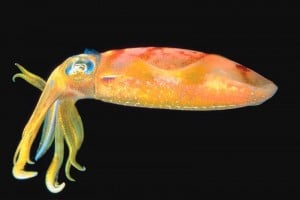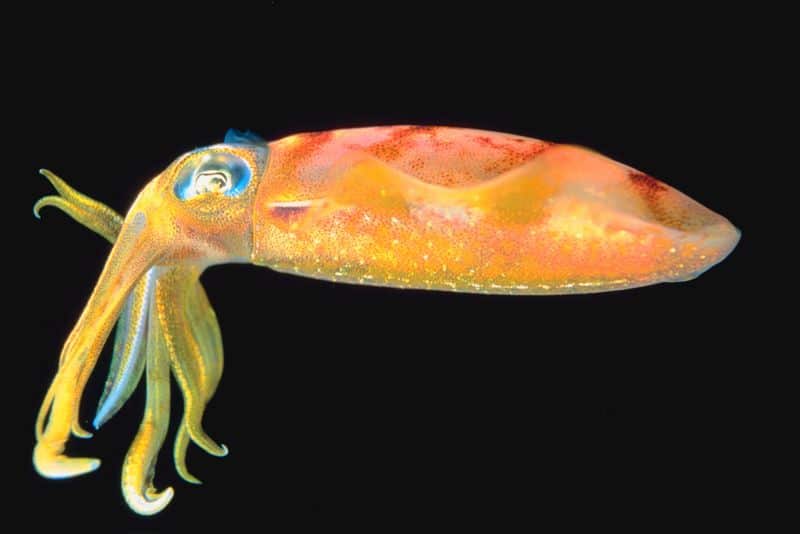by Dr. Sarah Oktay, Director, University of Massachusetts Nantucket Field Station
It’s been four years since I last wrote about squid, and their eggs have been washing up around our island during the last two weeks. It looks like we may have a good population of squid this year. Squid are most abundant in Nantucket Sound in May and June. On June 1, squid eggs were reported at Great Point, Smith Point, and other beaches around Nantucket. Females lay hundreds of eggs in capsules that they attempt to attach to the sea floor along with their sister squid eggs; but these often come loose and wash ashore.

Squid are in the order Teuthida, which comprises around 300 species. The origins of the word Teuthida and its relationship to squid are a bit sketchy. I love etymology, so I snooped around a bit and the best I could find was that Teuthis was a city in ancient Arcadia and also the name of a Greek general from that city who fought in the Trojan war. Teuthis speared the goddess Athena in the thigh when she tried to convince him not to return early from war with his army. The spear he used and the shape of the squid appear to have led to the name. That story was right on the tip of my tongue along with the two years of Latin I have forgotten.
Squid have a distinct head, bilateral symmetry, a mantle, and arms. Squid, like cuttlefish, have eight arms arranged in pairs and two longer tentacles. Tentacles are longer then arms and they usually only have suckers at their tips. The squid is one of the most highly developed invertebrates, well adapted to its active, carnivorous, predatory life. All squid have a mouth with a radula which is a file-like organ that scrapes nutrients from food sources. Squid hatchlings will eat the yolks from their eggs sacs for 4-5 days, then progress to eating copepods and other zooplankton, eventually graduating to fish and shrimp as they get larger. Cannibalism has also been documented. It sounds like they basically lick their meaty prey like lollipops: yum.
Squid are intelligent animals, for example, groups of Humboldt squid hunt cooperatively, using active communication. Their skin is covered in chromatophores, which enable the squid to change color to suit its surroundings, making it effectively camouflaged. Controlled by the nervous system, the camouflage can change in a split second and their shoaling behavior with rapid color changes is quite beautiful. Squid breathe through gills, and, like its cousin the octopus, will squirt a cloud of inky material from its ink sac when in danger. The circulatory and nervous systems are highly developed and the eyes of the squid are extremely evolved and often studied. The images squid see through hard lens on each side of the head is focused by changing the position of the lens, as in a camera or telescope versus changing the shape of the lens, like humans. Giant squid, which measure 40 feet and longer, and their smaller cousin, the Loligo pealei, have large optic nerves. Some deep-sea forms have luminescent organs. More squid fun facts: they have three hearts and limited hearing. Probably the most reported squid fact is one we can’t go into a lot of detail here, but let’s say, except for a type of barnacle, deep sea male squid are the most well endowed of all creatures.
The Longfin Inshore Squid (Loligo pealeii) is a species of squid of the family Loliginidae. It has recently been renamed the Doryteuthis (Amerigo) Pealeii, and this is the species we see most often around Nantucket.
When people aren’t eating them, squid are also harvested in bulk each spring for research by fishermen for scientists at the Marine Biological Laboratory in Woods Hole and other labs and universities across the country. Squid were long prized by scientists for their huge axons. More than 100 times the size of a human axon, the squid’s axon is roughly a millimeter in diameter and the largest nerve fiber on Earth. The enormous size allows scientists to study how signals are sent along the length of the axon to other nerve cells or muscles. Squid research today focuses on everything from evaluating the progression of Alzheimer’s damage in the brain to investigating cures for various eye diseases.
The animal is a migratory creature that comes to Cape waters every spring to spawn. They live offshore in deeper cooler water during the winter. If you have ever seen squid reproduction, you would certainly have not forgotten it. In early spring, squid “dating” starts as the dominant males fight for the opportunity to copulate with the females. The female gather the sperm from one or more partners in the off-shore mating ritual. When she arrives inshore, the female pulls a jelly-like matrix of eggs out of her body and holds it her arms and releases the stored sperm to fertilize hundreds of eggs. It has been documented by Dr. Roger Hanlon of the Woods Hole Marine Resources Center that sneaker males may lay in wait for females to deposit their egg sacs and fertilize the eggs at the last second, winning out over the older sperm the female collected earlier.
Many creatures like gray seals, stripers, and common dolphins feed on squid. Large groups of squid aggregate both south and north of the island each summer; sometimes drawing squid loving marine mammals.
The Longfin Inshore Squid spawns year-round and most scientists agree that they only live on average for one year (sometimes only 6-8 months), although this conclusion was only recently reached as a result of studies of the animal’s statocyst, a calcium carbonate rock in the animal’s balance organ that grows in rings that are laid down daily. Individuals hatched in summer generally grow much faster than those hatched in winter. The species presents sexual dimorphism, with most males growing faster and reaching larger sizes than females. The dorsal-mantle length of some males can reach 40 cm, although most squids commercially harvested are smaller than 30 cm long. They mate right before they die. Scientists at Woods Hole have discovered that the males freak out and get very aggressive when they encounter eggs. Researchers first noticed this effect while studying male squid arriving at breeding grounds where females had already started laying egg capsules. Each egg capsule contains 150 to 200 eggs. A female squid will lay 20 to 30 capsules over a period of up to several weeks, during which time she will mate with multiple males. The scientists noticed that, when male Longfin Squid saw egg capsules laid on the seafloor, the squid would swim toward the eggs and wrap their arms around them. They would then become enraged and attack each other.
Illex and Longfin squid are regulated under the Atlantic Mackerel, Squid and Butterfish Management Plan. Currently the season is divided into three or four periods with set quotas for some seasons and no limits during other seasons, effectively allowing the fishery to be open with few limits on size or number caught. Squid populations are replaced twice a year so fishing pressure is normally not a problem for them as long as some squid are left in the population at any given time. Spacing the allowed harvest throughout the year ensures fishing pressure isn’t concentrated too heavily at one time and allows the fishery to operate year-round.
Many of you know that squid are attracted to light. On several oceanographic cruises that I have been on, we use bright working lights at night that would attract huge schools of squid in the Gulf of Mexico. Fishermen have been using their propensity to come to lights for many years. Squid are also a part of the Cape and Islands recreational fishery. Fishing for squid from lighted spots of docks or off boats is a very popular activity on both sides of the Sound. Jigging for squid on the docks is a tradition on Nantucket, but there is a right way and a wrong way to jig for them, and spraying ink on other people’s boats is the wrong way. If you go down to the docks to jig for squid, stay away from docked boats and watch out for signs regulating where you can fish.



